Major Tribes, Tribal Areas & their Problems- 1 | Geography Optional for UPSC PDF Download
Tribes in India
A tribe in India is a social group within a traditional society, consisting of households connected by shared culture, dialect, social, economic, religious, or blood ties. Each tribe has distinct qualities and characteristics that make it a unique cultural, social, and political entity.- Race and ethnicity are two different aspects of human identity. Race is related to biology and refers to the small genetic variations among human populations due to geographic diversity. These variations result in different physical appearances, such as skin color, eye color, facial structure, and hair color. On the other hand, ethnicity pertains to cultural factors like nationality, regional culture, ancestry, and language. It signifies shared cultural traits, linguistic or religious characteristics, and a common group history. Examples of ethnic groups in India include Indo-Aryan, Dravidian, and Mongoloid.
- India is often regarded as a melting pot of races and tribes, possessing one of the largest and most diverse tribal populations in the world. According to the 2011 census, the tribal population in India is 104 million, accounting for 8.6% of the country's total population. Madhya Pradesh has the largest number of tribal people (15.3 million), while Lakshadweep has the highest tribal population as a percentage of its total population (94.8%). The largest tribe in India is the Bhil tribe, with nearly 46 lakh members, and the smallest is the Andamanese tribe, with only 19 members.
- The Indian Constitution recognizes tribal communities under 'Schedule 5,' making these tribes known as 'Scheduled Tribes.' Article 366 (25) defines scheduled tribes as "such tribes or tribal communities or parts of or groups within such tribes or tribal communities as are deemed under Article 342 to be Scheduled Tribes for the purposes of this Constitution."
Article 342
- Article 342 of the Constitution states that the President of India has the authority to designate specific tribes or tribal communities, or parts within these communities, as Scheduled Tribes for a particular State or Union Territory. This designation is done through a public notification and in consultation with the Governor of the State in question.
- Any changes to the list of Scheduled Tribes can only be made by an Act of Parliament. This means that once a tribe or tribal community has been designated as a Scheduled Tribe through a Presidential notification, it cannot be altered by any subsequent notifications.
- The Article also stipulates that the listing of Scheduled Tribes should be done on a State or Union Territory basis, rather than on an all-India basis. This means that each State or Union Territory has its own unique list of Scheduled Tribes, which may differ from those in other regions.
Ministry of Tribal Affairs
- The Ministry of Tribal Affairs is an Indian government department dedicated to the comprehensive development of the country's Scheduled Tribes, who are among the most underprivileged members of society. Established in 1999 as a result of the division of the Ministry of Social Justice and Empowerment, its primary objective is to address the socio-economic development of Scheduled Tribes in a coordinated and strategic manner.
- As the central authority for overall policy, planning, and coordination, the Ministry of Tribal Affairs oversees the development programs for Scheduled Tribes. The responsibility for implementing and managing sector-specific initiatives, as well as monitoring, evaluating, and coordinating these efforts, falls under the jurisdiction of relevant Central Ministries, Departments, State Governments, and Union Territory Administrations. In this way, the Ministry of Tribal Affairs ensures a focused and organized approach to the development and welfare of India's Scheduled Tribes.
National Commission for Scheduled Tribes (NCST)
- The National Commission for Scheduled Tribes (NCST) was established by amending Article 338 and inserting a new Article 338A in the Constitution through the Constitution (89th Amendment) Act, 2003.
- By this amendment, the erstwhile National Commission for Scheduled Castes and Scheduled Tribes was replaced by two separate Commissions namely-
- the National Commission for Scheduled Castes (NCSC)
- the National Commission for Scheduled Tribes (NCST) w.e.f. 19 February 2004.
Tribal Sub Plan (TSP) strategy
- The Tribal Sub Plan (TSP) strategy is a Government of India initiative aimed for the rapid socio-economic development of tribal people.
- The funds provided under the Tribal Sub Plan of the State have to be at least equal in proportion to the ST population of each State or UTs.
- Similarly, Central Ministries/Departments are also required to earmark funds out of their budget for the Tribal Sub-Plan. As per guidelines issued by the Planning Commission, the Tribal Sub Plan funds are to be non-divertible and non-lapsable.
- The National Commission for Scheduled Tribes is vested with the duty to participate and advise in the planning process of socio-economic development of STs, and to evaluate the progress of their development under the Union and any State.
Particularly Vulnerable Tribal Groups (PVTGs)
PVTGs are more vulnerable among the tribal groups. In India, tribal population makes up for 8.6% of the total population.
- 75 tribal groups have been categorized by Ministry of Home Affairs as Particularly Vulnerable Tribal Groups (PVTG)s. PVTGs reside in 18 States and UT of A&N Islands.
- They have declining or stagnant population, low level of literacy, pre-agricultural level of technology and are economically backward.
- They generally inhabit remote localities having poor infrastructure and administrative support.
Identification:
In 1973, the Dhebar Commission created Primitive Tribal Groups (PTGs) as a separate category, who are less developed among the tribal groups.
- In 1975, the Government of India initiated to identify the most vulnerable tribal groups as a separate category called PVTGs and declared 52 such groups, while in 1993 an additional 23 groups were added to the category, making it a total of 75 PVTGs, spread over 18 states and one Union Territory (A&N Islands) in the country (2011 census).
- Among the 75 listed PVTG’s the highest number are found in Odisha (13), followed by Andhra Pradesh (12).
In 2006, the Government of India renamed the PTGs as PVTGs.
Scheme for development of PVTGs:
- The Ministry of Tribal Affairs implements the Scheme of “Development of Particularly Vulnerable Tribal Groups (PVTGs)” exclusively for them.
- Under the scheme, Conservation-cum-Development (CCD)/Annual Plans are to be prepared by each State/UT for their PVTGs based on their need assessment, which are then appraised and approved by the Project Appraisal Committee of the Ministry.
- Priority is also assigned to PVTGs under the schemes of Special Central Assistance (SCA) to Tribal Sub-Scheme (TSS), Grants under Article 275(1) of the Constitution, Grants-in-aid to Voluntary Organisations working for the welfare of Scheduled Tribes and Strengthening of Education among ST Girls in Low Literacy Districts.
- Jiban Sampark Project of Odisha
- The Project is being undertaken in association with UNICEF.
- It aims to generate awareness among Particularly Vulnerable Tribal Groups (PVTG) in Odisha on various development and welfare initiatives of the State Government, especially on women and child welfare.
- The focus areas of the Project are skill development, empowering communities, cooperation, and innovation among the groups.
The criteria followed for determination of PVTGs are as under:
- A pre-agriculture level of technology.
- A stagnant or declining population.
- Extremely low literacy.
- A subsistence level of the economy.
Denotified Tribes
- Denotified tribes refer to those communities that were categorized under the Criminal Tribes Act of 1871 during British rule in India. These tribes were labeled as criminals and were known for repeatedly committing non-bailable offenses. As a result, they were required to register with local authorities, and their movements were heavily restricted.
- After India gained independence, the Criminal Tribes Act was abolished, and these tribes were placed under the Habitual Offenders Act. However, they continue to face numerous challenges due to their past categorization, making it difficult for them to meet their basic needs and integrate into mainstream society.
- To address this issue, the government-appointed Idate Commission recommended repealing the Habitual Offenders Act in order to promote inclusive development and improve the living conditions of these tribes.
Important Tribes of India (Statewise)

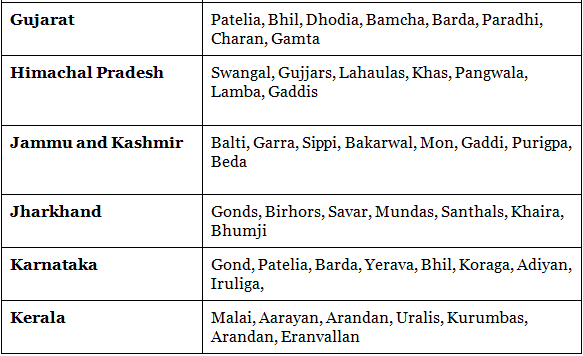
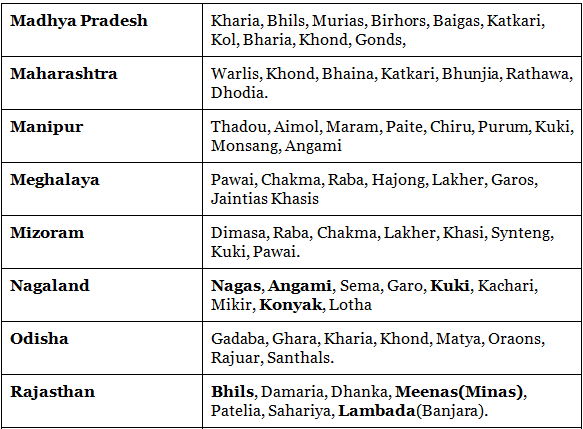


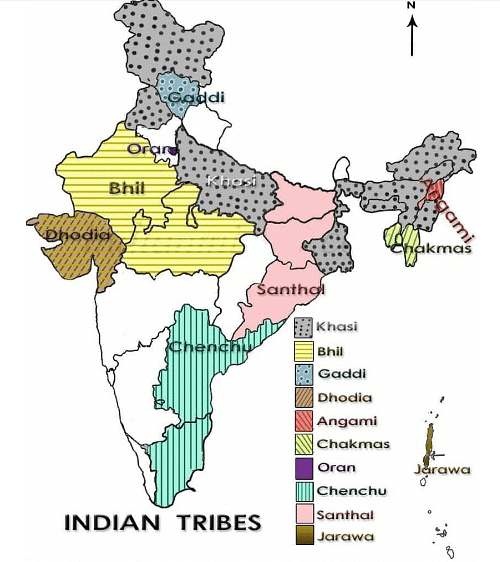
Most Famous Tribal Groups
Bhils Tribe- The Bhils are a tribe found mostly in the mountain ranges of Udaipur and in some districts of Rajasthan.
- The Bhils are the largest tribes in India.
- Popularly known as the Bow men of Rajasthan
- They speak the Bhili language.
- Their celebrations are the Ghoomar dance, Bhagoria Mela during Holi, Than Gair-a dance drama, and the Baneshwar Fair during Shivaratri.
Gonds Tribe
- Found in the Chhindwara district of Madhya Pradesh and in parts of Maharashtra, Orissa, and Andhra Pradesh, the Gonds are the second biggest tribe in India.
- They are known for their valor and speak many Indian languages including the Dravidian Gondi language.
- They have houses of mud walls and thatched roofs in the Gondi forests.
- Agriculture is their main occupation.
- Keslapur Jathra and Madai are their festivals.
Baiga Tribe
- The Baiga (means sorcerers) is one of the Particularly Vulnerable Tribal Groups (PVTGs).
- They mainly live in Chhattisgarh, Jharkhand, Bihar, Odisha, West Bengal, Madhya Pradesh, and Uttar Pradesh.
- Traditionally, the Baiga lived a semi-nomadic life and practiced slash and burn cultivation. Now, they are mainly dependent on minor forest produce for their livelihood.
- Bamboo is the primary resource.
- Tattooing is an integral part of Baiga culture, every age and body part has a specific tattoo reserved for the occasion.
- Munda Tribe (means headmen of village)
- This tribe is found in Jharkhand and parts of Chattisgarh, Bihar, Odisha, and West Bengal.
- Their life is simple and basic. They speak the Mundari language. The Mundas were hunters in the past but now are laborers in farms.
- They follow the Sarna religion owing allegiance to a God called Singbonga which means the Sun God.
- Their language is Killi and Nupur dance is the main entertainment.
- The Munda tribes celebrate the Mage, Karam, Sarhaul, and Phagu festivals.
Santhal Tribes
- The Santhal tribes represent a significant tribal group primarily residing in West Bengal, as well as in Bihar, Odisha, Assam, and forming the largest tribe in Jharkhand. They gained historical prominence as the first tribe to resist British rule during the 1855 Santhal Rebellion, which eventually led to the establishment of the separate Santhal Parganas district.
- Primarily relying on agriculture and livestock for their livelihoods, the Santhal people are also known for their exceptional hunting skills. They follow the Sarna religion and do not have temples or idol worship practices. Instead, they celebrate various traditional festivals, such as Karam and Sahrai, which showcase their vibrant culture. The Santhali dance and music performances serve as major attractions, capturing the essence of this unique and diverse tribal community.
Meenas
- The Meena community is primarily located in the Indian states of Rajasthan and Madhya Pradesh. They believe that they are the descendants of the Matsya avatar (the fish incarnation) of the Hindu god Vishnu and the people of the ancient Matsya Kingdom.
- The Meena tribe is divided into several clans and sub-clans, known as adakhs, each named after an ancestor. Some examples of these adakhs include Ariat, Ahari, Katara, Kalsua, Kharadi, Damore, Ghoghra, Dali, Doma, Nanama, Dadore, Manaut, Charpota, Mahinda, Rana, Damia, Dadia, Parmar, Phargi, Bamna, Khat, Hurat, Hela, Bhagora, and Wagat.
- In Rajasthan, members of the Meena caste are opposed to the inclusion of the Gurjar community into the Scheduled Tribe category. They fear that this would lead to a reduction in the benefits reserved for the Meena community under the Scheduled Tribe reservation system.
- The Meena tribe is known for being one of the most marginalized communities in India. They are not only geographically isolated but also continue to follow traditional lifestyles, which are considered primitive by some.
Toto Tribe
- Totapara village in the Alipurdoar district of West Bengal is home to the Toto tribe.
- Their language has no script and is influenced by Nepali and Bengali.
- They trade vegetables and fruits to maintain their simple life.
- They believe in God Ishpa and Goddess Cheima, though they proclaim to be Hindus.
Bodo Tribe
- The Bodo tribe is found in Assam and parts of West Bengal and Nagaland.
- They are believed to be the early indigenous settlers of Assam.
- They belong to Indo-Mongoloid family. They speak a Tibetan-Burmese language, the Bodo.
- The weaving of handloom products is an intrinsic part of their culture.
- They celebrate the Baishagu festival in spring, dedicated to Lord Shiva, Hapsa hatarani, Domashi.
Angami Tribe
- The Angami Nagas is one of the major tribes found in the district of Kohima in Nagaland.
- The men dress in white Mhoushu and black Lohe. The women wear Mechala and ornaments of beads, mask pendants, bracelets, etc.
- The tribe is best known for the famed Hornbill Festival which attracts crowds from various parts of the world.
- Hornbill Festival – first started in the year 2000 is celebrated in the month of December every year. It starts on December 1, a day that is celebrated as Nagaland Statehood Day, and it goes on for ten days, ending on December 10.
- The 17 tribes that take part in the festival are Angami, Ao, Chakhesang, Chang, Dimasa Kachari, Garo, Khiamniungan, Konyak, Kuki, Lotha, Phom, Pochury, Rengma, Sangtam, Sumi, Yumchungru, and Zeliang.
- Their intricate art and woodwork and work in bamboo and cane are beautiful. They speak different dialects like Gnamei, Ngami, Tsoghami.
Rengmas Tribe
- Distribution: Nagaland
- They are one of the seventeen major Naga Tribes.
- They follow patriarchal system.
- Originally they were animist. They believed in various gods and goddess. Christianity is also present among the tribe.
- Agriculture is the main occupation. They practice Jhumming. Women are expert weavers.
Koyank Tribe (means black head)
- Distribution: Nagaland
- They are the largest out of 17 officially recognized tribes in Nagaland.
- They are known as ‘those violent headhunters with tattooed faces.
- One of the last headhunters, they now practice agriculture and hunt seasonally. More than 95% of them follow Christianity.
- The men wear earrings made out of deer horn, necklace made out of boar tusks, and brass heads.
- Festivals: Aoling to welcome spring, ‘Lao Ong Mo’ harvest festival
Bhutia Tribe
- The Bhutias are mainly found in Sikkim and parts of West Bengal and Tripura.
- They are of Tibetan ancestry and speak Lhopo or Sikkimese language.
- They are known for their art and cuisine. The steamed meat dumplings called momos are their staple food.
- Thukpa, noodles in a broth, is another of their dishes. Losar and Loosong are the festivals celebrated.
Bru or Reang Tribe
- Bru or Reang is a community indigenous to Northeast India, living mostly in Tripura, Mizoram, and Assam. Reangs belongs to Indo-Mongoloid racial stock.
- Reangs are the second largest tribal community of Tripura. In Tripura, they are recognized as a Particularly Vulnerable Tribal Group.
- In Mizoram, they have been targeted by groups that do not consider them indigenous to the state.
- In 1997, following ethnic clashes, nearly 37,000 Brus fled Mamit, Kolasib, and Lunglei districts of Mizoram and were accommodated in relief camps in Tripura.
- Since then, 5,000 have returned to Mizoram in eight phases of repatriation, while 32,000 still live in six relief camps in North Tripura.
(i) In June 2018, community leaders from the Bru camps signed an agreement with the Centre and the two-state governments, providing for repatriation in Mizoram. But most camp residents rejected the terms of the agreement.
(ii) The camp residents said that the agreement didn’t guarantee their safety in Mizoram.
Chakmas
- Distribution: Mizoram, Tripura, Arunachal pradesh
- The Chakma possess strong genetic affinities to Tibeto-Burman groups in Northeast India and to East Asian and populations.
- They believe they are also part of Buddha’s Sakya clan from Himalayan tribes. After many struggles to survive, they gradually migrated to Arakan, and spread their territory to the nearby hills of Chittagong Hill Tracts.
- During the construction of the Kaptai Dam in the 1960s, many Chakma settlements were submerged due to the creation of the artificial Kaptai Lake.
- In the mid-1970s, the eruption of the Chittagong Hill Tracts conflict caused some Chakma people to become refugees in NEFA (present Arunachal Pradesh). The conflict ended in 1997 with the Chittagong Hill Tracts Peace Accord.
- Language is Chakma part of Indo-Aryan group.
- Religion is mainly Theravada Buddhism
- Festivals: Bizu, Alphaloni, Buddha Purnima and Kathin Civar Dan.
Lepcha Tribe
- Lepcha is a tribe of the Himalayan range lives at the North-East corner of India. They largely resides at Meghalaya, Arunachal Pradesh, Bhutan, Sikkim, and Darjeeling.
- Lepchas are Mongoloid tribe. Their language is an admixture of Nepalese and Sikkims languages, which is very familiar with the Indo-Chinese language. They themselves call “Rong”.
- Lepchas live on rearing a large number of cattle and milch cows besides cultivation of Agricultural and Horticultural crops.
- Originally Lepchas were the nature worshiper and had beliefs in witch-craftship and spirits. But in due course, they embarrassed Buddhism.
- In Tripura, they are known as Nepalese and their social and community relationship also bounded with Nepalese.
Khasi Tribe
- This tribe is mainly spotted on the Khasi Hills of Meghalaya and in parts of Assam, Manipur, Arunachal Pradesh, and West Bengal.
- Most of the Khasis follow Christianity.
- They speak Khasi – an Austro- Asiatic language
- The property of the Khasis is passed on from the mother to the youngest daughter.
- The women wear silver or gold crown on their head and the men wear large earrings.
- The tribe plays plenty of music and a wide range of musical instruments like drums, guitars, flutes, cymbals, etc.
- Their major festival, the Nongkrem festival is five days long when the women wear a dress called Jainsem and the men a Jymphong.
Garo Tribe
- Garo tribes are mainly found in the hills of Meghalaya and parts of Assam, Nagaland, and West Bengal.
- The tribe is one of the few matrilineal societies in the world. Garo architecture is quite unique. Nokmong, Nokpante, Jamadaal and Jamsireng are some of them.
- The tribal women wear a variety of traditional ornaments. The men wear their traditional dress with a turban with feathers stuck in them.
- The festival of Wangala is their celebration.
Nyishi Tribe
- This tribe inhabits the mountains of Arunachal Pradesh with the majority of them from districts of Kurung Kumey, Papum Pare, Upper, and Lower Subansiri.
- Nishi is the language spoken by them.
- A good majority of them have converted to Christianity.
Gaddis Tribe
- Distribution: Himachal Pradesh
- They mainly dwell around the Dhauladhar mountain range, Chamba, Bharmaur, and the areas near to Dharamshala
- The main occupation is pastoralism and they make their livelihood by rearing and selling sheep, goats, mules, and horses.
- Most of them are Hindus and a few Muslims.
- They speak the Gaddi Language but for writing, they use Takri and Hindi.
- Festivals: Shivarathri, Jatra.
Gujjars
- Distribution: Himachal Pradesh, Uttar Pradesh, Kashmir
- The Gurjars/Gujjars were no doubt a remarkable people spread from Kashmir to Gujarat and Maharashtra, who gave an identity to Gujarat, established kingdoms, entered the Rajput groups as the dominant lineage of Badgujar, and survive today as a pastoral and a tribal group with both Hindu and Muslim segments.
- They mainly practise pastoral and dairy farming.
- Practice transhumance.
Warli Tribe
- The tribe is found in the Maharashtra-Gujarat border and surrounding areas.
- This tribe is well known for the Warli Art, where a mixture of cow dung and earth, rice paste, bamboo stick, red ochre are used to create art, paintings, and murals.
- They conduct the Tarpa dance during the harvest season and the Warli Folk Art Dancing People Festival during March of every year.
Khonds/ Dongari Khond
- Distribution: Orissa
- Their native language is Kui, a Dravidian language written with the Oriya script.
- They are nature-worshipping forest dwellers.
- Vedanta Resources, mining company, was set to destroy the forests, wildlife, and way of life of the Dongria Kondh people. Their four-year-long protests finally paid off as the government has now banned Vedanta from mining in Niyamgiri Mountain and in their forests.
- Practice shifting cultivation locally called Podu.
Chenchu Tribe
- This tribe is indigenous to Andhra Pradesh and inhabits the forests of Nallamala Hills.
- They are also present in the districts of Kurnool, Nalgonda, Guntur.
- They hunt and trade in jungle products like honey, roots, gums, fruits, and tubers.
- They speak the Chenchu language with a Telugu accent and are a very ritualistic lot.
- Festivals: Mahashivarathri is celebrated by them with great pomp especially in Amarbad tiger reserve Telangana.
Lambadas
- Distribution: AP, Karnataka, Rajasthan
- They are the largest tribe of AP.
- They live in exclusive settlements of their own called Tandas, usually away from the main village, tenaciously maintaining their cultural and ethnic identity.
- They are expert cattle breeders and largely subsist by sale of milk and milk products.
- Festivals: Teej, Ugadi etc.
Apatani Tribes (or Tanni)
- Aaptani are a tribal group of people living in the Ziro valley in Arunachal Pradesh.
- They speak a local language called Tani and worship the sun and the moon.
- They follow a sustainable social forestry system.
- They celebrate major festivals – Dree with prayers for a bumper harvest and prosperity of all humankind and Myoko to celebrate Friendship.
- The Apatanis practice aquaculture along with rice farming on their plots. Rice-fish culture in the valley is a unique practice in the state, where two crops of rice (Mipya and Emoh) and one crop of fish (Ngihi) are raised together.
- UNESCO has proposed the Apatani valley for inclusion as a World Heritage Site for its “extremely high productivity” and “unique” way of preserving the ecology.
Siddis Tribe
- This tribe of Karnataka is believed to have descended from the Bantu people of Southeast Africa. History says that the people were brought in as slaves by the Portuguese.
- They are found in various parts of Karnataka.
- The majority of them are Christians while others follow Hinduism and Islamism. They are fond of ritual practices, dance, and music.
Kodava Tribe
- This tribe from Mysore, Karnataka is concentrated in Coorg.
- Well known for their bravery, the tribe is a patrilineal tribe from Kodagu or Coorg.
- They speak the Kodava language.
- They are basically agriculturists. The people of the tribe, both men and women, are very passionate about hockey.
- Kodavas are the only people in India permitted to carry firearms without a license.
Koragas
- Distribution: Karnataka and Kerala
- They traditionally lived in structures made of leaves, called koppus and also dressed in leaves.
- They were subjected to inhuman practice of Ajalu which was banned by Karnataka Government in 2000. But it was in news recently due to it prevelance.
- They practice endogamy with regard to their three main subdivisions, the Sappina, Ande and Kappada Koraga.
- They worship spirits known as Bhutas as well as some devas and a sun god.
- Koraga people are known for drum beating (dollu or dolu beating) and Flute music and dance involving both men and women.
- Language is Koraga which has no script.
Kadar
- Distribution: Kerala and Tamil Nadu
- They live in forests and do not practice any agriculture but are specialists in collection of honey, wax etc which they trade to obtain food items.
- Live in temporary shelters with thatch leaves and shift according to employment availability.
- They worship many jungle spirits.
Toda Tribe
- The Todas are found in parts of the Nilgiris mountain in Tamil Nadu.
- Their livelihood depends on cattle farming and dairy. Their skill in architecture is reflected in the oval and tent-shaped bamboo houses with thatched roofs.
- Toda embroidery work, Pukhoor, is well acclaimed. Their most important festival is Modhweth.
Irular Tribe
- The tribe inhabits areas of the Nilgiri mountain in Tamil Nadu and Kerala.
- They are the second-largest tribe in Kerala and are found mostly in the Palakkad region.
- They are mainly farmers and dependent on the production of paddy, dhal, Raggi, chilies, turmeric, and plantains.
- They are ritualistic, believe in their own Gods and are known for their skills in black magic.
Kattunayakan (King of Jungle)
- Distribution: Kerala, Tamil Nadu, Andhra Pradesh, and Karnataka
- Hunting and collecting forest produce are the two main means of living.
- Kattunayakar believe in Hinduism and have a language, which is a mixture of all Dravidian languages. The main deity of the tribe is Lord Shiva and (jakkamma [Nayakkar])under the name of Bhairava. They also worship animals, birds, trees, rock hillocks, and snakes, along with the other Hindu deities.
- Child marriages were common before the 1990s, but now the girls marry after attaining puberty. Monogamy is the general rule among the Kattunayakar community.
- Kattunayakar are non-vegetarians and are fond of music, songs, and dancing.
- They are also called Cholanaickar and Pathinaickars.
Cholanayakan
- Distribution: southern Kerala State, especially Silent Valley National Park.
- They are called Cholanaikan because they inhabit the interior forests. ‘Chola’ or ‘shoals’ means deep evergreen forest, and ‘naikan’ means King. They are said to have migrated from Mysore forests.
- The Cholanaikkans speak the Cholanaikkan language, which belongs to the Dravidian family.
- They live in rock shelters called ‘Kallulai’ or in open campsites made of leaves.
- They subsist on food-gathering, hunting and minor forest produce collection.
Kanikaran Tribe
- Kanikkaran are a tribal community found in the southern parts of Kerala and Tamil Nadu states in India.
- Though they cultivate everything and make agriculture as the main profession, they have a special liking for fishing and hunting.
- Kaanikkar Nritham is a form of group dance performed as a rural offering.
- The Kanikkars are semi-nomadic, living in temporary huts of bamboo and reeds. These are generally situated on hillsides.
Kurumba Tribe
- This is a major tribe found in parts of Kerala and Tamil Nadu. They are one of the earliest settlers of the Western Ghats.
- They lead a simplistic lifestyle depending on agriculture and gathering of honey and wax.
- They are adept at formulating traditional herbal medicines.
- They are well known in the region for their skills in witchcraft and magic.
Great Andamanese Tribe
- The tribe is based in the ‘Strait Island’ of Andaman and Nicobar Islands.
- The members speak Jeru dialect among themselves and their number stands at 51 as per the last study carried out by Andaman Adim Janjati Vikas Samiti in 2012.
- More than 5,000 Great Andamanese lived in the Islands before British settlers arrived in the 19th century.
- However, hundreds were killed in the conflict as they defended their territories from British invasion, and thousands more were wiped out in epidemics of measles, influenza, and syphilis (a bacterial infection).
Onges
- The Onge were semi-nomadic and fully dependent on hunting and gathering for food.
- The Onge are one of the least fertile people in the world. About 40% of the married couples are sterile.
- Onge women rarely become pregnant before the age of 28.
- Infant and child mortality is in the range of 40%.
- The Ong speak the Önge language. It is one of two known Ongan languages (South Andamanese languages).
- A major cause of the decline in Onge population is the changes in their food habits brought about by their contact with the outside world.
Shompens
- The Shompen are a hunter-gatherer subsistence people, hunting wild game such as pigs, birds and small animals while foraging for fruits and forest foods.
- The lowland Shompen build their huts on stilts and the walls are made of woven material on a wood frame and the roof of thatched palm fronds, and the structure is raised on stilts.
- A man usually carried a bow and arrows, a spear and through his loincloth belt, a hatchet, knife and fire drill.
- The Shompen are a hunter-gatherer subsistence people, hunting wild game such as pigs, birds and small animals while foraging for fruits and forest foods.
- Language is Shompen belonging to Austroasiatic Language.
Sentinelese
- They are one of the world’s last uncontacted peoples.
- The Sentinelese are hunter-gatherers. They likely use bows and arrows to hunt terrestrial wildlife and more rudimentary methods to catch local seafood, such as mud crabs and molluscan shells.
- Some of their practices have not evolved beyond those of the Stone Age; they are not known to engage in agriculture. It is unclear whether they have any knowledge of making fire though investigations have shown they use fire.
Jarawa Tribe
- The Jarawas are a native tribe residing in the Andaman Islands in India, specifically in parts of South Andaman and Middle Andaman Islands. Their interaction with the outside world is limited, and as a result, little is known about their culture, traditions, and society.
- In the 1970s, the construction of the controversial Great Andaman Trunk Road began, cutting through the Jarawas' western forest homeland. This led to increased contact between the tribe and outsiders, occasionally resulting in trade but also causing the spread of diseases.
- On January 21, 2013, Justices G.S. Singhvi and H.L. Gokhale passed an interim order prohibiting tourists from using the trunk road that passes through Jarawa territory. In response to this order, a petition was filed on behalf of local residents, stating that the Andaman Trunk Road is an essential route connecting over 350 villages. Consequently, on March 5, 2013, the Supreme Court reversed its interim order, allowing the road to be fully reopened. However, vehicles are only permitted to travel in large groups four times a day.
List of PVTGs in India

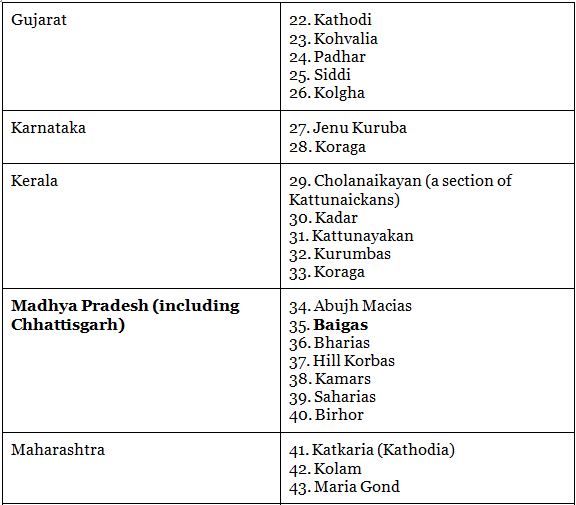
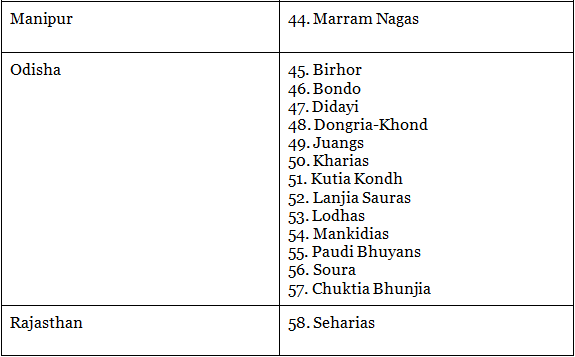
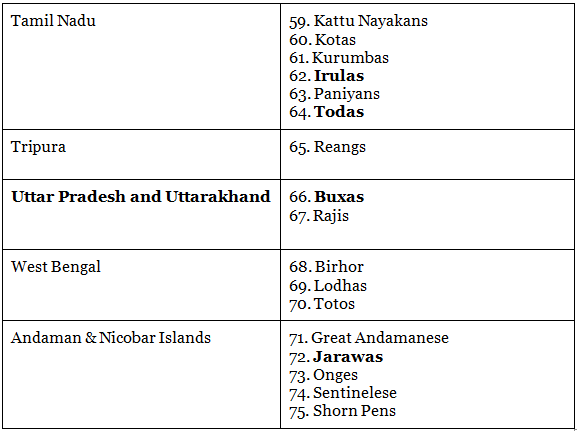

Xaxa Committee on Tribal Communities of India
- The Xaxa Committee on Tribal Communities of India was constituted in 2013 by the Prime Minister's Office and chaired by Prof. Virginius Xaxa.
- The committee was tasked with examining the socio-economic, educational, and health status of tribal communities and recommending appropriate measures to improve these aspects.
- The committee's report, submitted in May 2014, focused on five critical issues: livelihood and employment, education, health, involuntary displacement and migration, and legal and constitutional matters.
- Despite significant resources allocated to address these issues, the status of tribes remains a critical gap in India's development.
- The committee also analyzed the functioning of legislation, such as PESA and FRA, and their violations, as well as issues like land acquisition, food security, detention and imprisonment, and the status of Particularly Vulnerable Tribal Groups (PVTGs) and De-notified Tribes.
Conclusion
In conclusion, India is home to a diverse array of tribes, each with its own unique cultural and social characteristics. The government has implemented various initiatives and strategies, such as the Tribal Sub Plan and the Ministry of Tribal Affairs, to address the needs and challenges faced by these communities, particularly the Particularly Vulnerable Tribal Groups (PVTGs). Despite these efforts, the socio-economic, educational, and health status of tribal communities remains a critical gap in India's development. The Xaxa Committee on Tribal Communities of India was established to further understand and address these issues, but there is still much work to be done to improve the quality of life for India's tribal populations.Frequently Asked Questions (FAQs) of Major Tribes, Tribal Areas & their Problems
What is the difference between race and ethnicity in the context of India's tribal population?
Race is related to biology and refers to the genetic variations among human populations due to geographic diversity, resulting in different physical appearances. Ethnicity pertains to cultural factors like nationality, regional culture, ancestry, and language, signifying shared cultural traits, linguistic or religious characteristics, and a common group history.
What is the significance of the Scheduled Tribes designation in the Indian Constitution?
The Indian Constitution recognizes tribal communities under 'Schedule 5,' making these tribes known as 'Scheduled Tribes.' This designation provides special protections and rights for these communities, aiming to uplift their socio-economic status and preserve their unique cultural heritage.
What is the role of the Ministry of Tribal Affairs in India?
The Ministry of Tribal Affairs oversees the development programs for Scheduled Tribes, ensuring a focused and organized approach to their welfare andz socio-economic development. It works in collaboration with relevant Central Ministries, Departments, State Governments, and Union Territory Administrations.
What are Particularly Vulnerable Tribal Groups (PVTGs) in India?
PVTGs are more vulnerable among the tribal groups, having declining or stagnant population, low level of literacy, pre-agricultural level of technology, and economically backward conditions. There are 75 tribal groups categorized as PVTGs in India, residing in 18 States and the Union Territory of Andaman & Nicobar Islands.
What was the purpose of the Xaxa Committee on Tribal Communities of India?
The Xaxa Committee was constituted to examine the socio-economic, educational, and health status of tribal communities in India and recommend appropriate measures to improve these aspects. The committee's report focused on five critical issues: livelihood and employment, education, health, involuntary displacement and migration, and legal and constitutional matters.
|
303 videos|636 docs|252 tests
|
FAQs on Major Tribes, Tribal Areas & their Problems- 1 - Geography Optional for UPSC
| 1. What are some of the most famous tribal groups in India? |  |
| 2. What are the major problems faced by tribal areas in India? |  |
| 3. How does the government address the problems faced by tribal communities in India? |  |
| 4. What are some of the major tribal areas in India? |  |
| 5. How do tribal communities contribute to India's cultural diversity? |  |
















